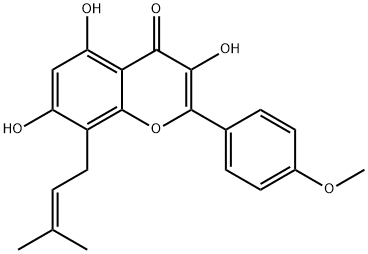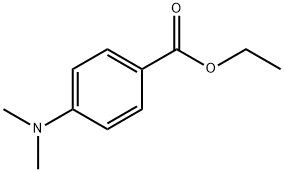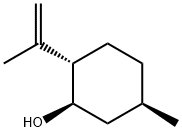
Product Details;
CasNo: 118525-40-9
Molecular Formula: C21H20O6
118525-40-9 Properties
- Molecular Formula:C21H20O6
- Molecular Weight:368.386
- Vapor Pressure:3.82E-14mmHg at 25°C
- Melting Point:239 °C
- Refractive Index:1.656
- Boiling Point:581.992 °C at 760 mmHg
- PKA:6.44±0.40(Predicted)
- Flash Point:206.679 °C
- PSA:100.13000
- Density:1.36 g/cm3
- LogP:4.09410
118525-40-9 Usage
Chemical Properties
Yellow crystalline powder, soluble in methanol, ethanol, DMSO and other organic solvents, derived from epimedium.
Uses
Icaritin is a hydrolytic product of Icariin, a traditional Chinese herbal medicine extracted from the Epimedium genus. Icaritin and Desmethylicaritin, is two metabolites of Icariin, dramatically inhibit the growth of most malignant cells. They also have significant antiangiogenesis properties, inhibiting or eliminating entirely the development of new malignant cells. Icaritin has been used in trials studying the treatment of Solid Tumors, Metastatic Breast Cancer, and Hepatocellular Carcinoma (HCC).
Biochem/physiol Actions
Icaritin is a component of Epimedium flavonoid isolated from Herba Epimedii, which enhances osteoblastic differentiation of mesenchymal stem cells (MSCs) while it inhibits adipogenic differentiation of MSCs by inhibiting PPAR-g pathway. Icaritin has no effect on MSCs proliferation. Also, icaritin potently inhibits chronic myeloid leukemia (CML) and breast cancer cells proliferation most likely by modulation of MAPK/ERK/JNK and JAK2/STAT3 /AKT signaling. As other flavonoids, icaritin may exert estrogen-like activities.
Synthesis
The novel total synthesis of icaritin, naturally occurring with important bioactive 8-prenylflavonoid, was performed via a reaction sequence of 8 steps including Baker-Venkataraman reaction, chemoselective benzyl or methoxymethyl protection, dimethyldioxirane (DMDO) oxidation, O-prenylation, Claisen rearrangement and deprotection, starting from 2,4,6-trihydroxyacetophenone and 4-hydroxybenzoic acid in overall yields of 23%. The key step was Claisen rearrangement under microwave irradiation.Total Synthesis of Icaritin via Microwave-assistance Claisen Rearrangement
Mode of action
Icaritin is a flavonoid first isolated from the Chinese herb H. epimedii that demonstrates anticancer activity against a variety of tumor cell lines. Icaritin was shown in vitro to sustain extracellular signal–regulated kinase (ERK) activity through stimulating estrogen receptors. Prolonged ERK activation arrested the cell cycle in the G2 stage and subsequently triggered apoptosis. It has been shown to inhibit fatty acid synthase, reducing IGF-1-induced activation of STAT3 in several melanoma cell lines.
InChI:InChI=1/C21H20O6/c1-11(2)4-9-14-15(22)10-16(23)17-18(24)19(25)20(27-21(14)17)12-5-7-13(26-3)8-6-12/h4-8,10,22-23,25H,9H2,1-3H3
118525-40-9 Relevant articles
Synthesis of icariin from kaempferol through regioselective methylation and para-Claisen - Cope rearrangement
Mei, Qinggang,Wang, Chun,Zhao, Zhigang,Yuan, Weicheng,Zhang, Guolin
, p. 1220 - 1225 (2015)
The hemisynthesis of the naturally occurring bioactive flavonoid glycoside icariin (1) has been accomplished in eleven steps with 7% overall yield from kaempferol. The 4?-OH methylation of kaempferol, the 8-prenylation of 3-O-methoxymethyl-4?-O-methyl-5- O-prenyl-7-O-benzylkaempferol (8) via para-Claisen-Cope rearrangement catalyzed by Eu(fod)3 in the presence of NaHCO3 , and the glycosylation of icaritin (3) are the key steps.
A novel anticancer agent, icaritin, induced cell growth inhibition, G1 arrest and mitochondrial transmembrane potential drop in human prostate carcinoma PC-3 cells
Huang, Xin,Zhu, Danyan,Lou, Yijia
, p. 26 - 36 (2007)
Icariin and icaritin with prenyl group have been demonstrated for their selective estrogen receptor modulating activities. We screened their effects on cell growth in human prostate carcinoma PC-3 cell line (estrogen receptor positive) in vitro. PC-3 cell line was used for the measurement of anti-carcinoma activities of 0-100 μmol/l icaritin and 30 μmol/l icariin. 1 μmol/l 17-β estradiol (E2) served as the estrogen positive control, and 1 μmol/l ICI 182,780 [7 α-[9 (4,4,5,5,5-pentafluoropentyl) sulfinyl] nonyl]-estra-1,3,5(10)-triene-3,17h-diol]] served as the specific estrogen receptor antagonist. Primary cultured rat prostate basal cells used as cell growth selective control. The growth-inhibitory effects were analyzed using MTT assay, and fluorochrome staining, flow cytometry, and immunoblotting were employed to illustrate the possible mechanisms. When treated with icaritin for 24 to 72 h, cell growth was strongly inhibited (at 48 h IC50 was 10.74 ± 1.59 μmol/l, P 50 could be observed when co-incubated with ICI 182,780. Icaritin-induced growth inhibition was associated with G1 arrest (P 2-M arrest depending upon doses. Consistently with G1 arrest, icaritin increased protein expressions of pRb, p27Kip1 and p16Ink4a, while showed decrease in phosphorylated pRb, Cyclin D1 and CDK4. Comparatively, icariin has much lower effects on PC-3 cells and showed only weak G1 arrest, suggesting a possible structure-activity relationship. These findings suggested a novel anticancer efficacy of icaritin mediated selectively via induction of cell cycle arrest but not associated with estrogen receptors in PC-3 cells.
Magnesium dicarboxylates promote the prenylation of phenolics that is extended to the total synthesis of icaritin
Fu, Xuewen,Lu, Xiaoxia,Wang, Chun,Wen, Yongju,Xiong, Wei,Zhang, Guolin,Zhang, Jichao
, p. 1117 - 1124 (2022/02/16)
The prenylation of phenolic substrates promoted by magnesium dicarboxylates was developed. An investigation of the scope demonstrated that substrates with electron-donating group(s) gave better yields than those with electron-withdrawing group(s). Althoug
Phosphate ester derivative of herba epimedii as well as preparation method and application of phosphate ester derivative
-
Paragraph 0033-0038, (2021/06/26)
The invention belongs to the technical field of medicines, and discloses a phosphate ester derivative of herba epimedii as well as a preparation method and application of the phosphate ester derivative. The chemical structural formula of the phosphate ester derivative of the herba epimedii is represented by the formula (1), wherein R1 is selected from groups defined in the specification, or R2 is selected from H or R1, and R3 is selected from H or a group defined in the specification. According to the phosphate ester derivative of the herba epimedii, the cytotoxicity of the partially modified derivative is remarkably enhanced compared with that of an unmodified derivative, and meanwhile the phosphate ester derivative of the herba epimedii has the anti-osteoporosis effect. The phosphate ester derivative of the herba epimedii can be applied to the field of preparation of drugs for prostate cancer cells, anti-osteoporosis health-care products, pharmaceutical excipients or drugs.
Convenient and efficient total synthesis method for icaritin and derivatives of icaritin
-
Paragraph 0063; 0084-0088, (2020/02/06)
The invention belongs to the field of natural medicine synthesis and particularly relates to a convenient and efficient total synthesis method for icaritin and derivatives of icaritin. The specific technical scheme is as follows: 2'-hydroxyacetophenone and benzaldehyde are used as raw materials, firstly, isopentene groups are introduced in aromatic rings of raw materials under the catalysis of anorganic polyacid metal ion complex, a flavonol framework is constructed under mild and green conditions, and an isopentenyl flavone compound comprising the icaritin and derivatives of icaritin is further synthesized. The method effectively overcomes the limitation of poor substrate solubility and poor regioselectivity when flavone is constructed firstly and then isopentene groups are introduced, the problems of frequent introduction and removal of protecting groups in a conventional isopentenylation method are solved, and the synthesis route is greatly simplified; and meanwhile, the problems of complex products and more byproducts in an isopentene group rearrangement method are solved. The total synthesis method provided by the invention is mild in condition, convenient to operate, high intotal yield and suitable for mass production of the isopentenyl flavone compound.
ANALOGS OF THE NATURAL PRODUCT ICARIIN
-
Paragraph 00168; 00192, (2020/03/02)
Provided herein are analogs of the natural product icariin represented by Structural Formula (I) or a pharmaceutically acceptable salt thereof. The analogs can be used to modulate (e.g., inhibit, such as by competitive inhibition) PDE5 and thereby treat a wide range of PDE5- mediated diseases, including cardiovascular, gastrointestinal, pulmonary, musculoskeletal, neurological and reproductive diseases. Also provided herein are compositions and methods including compounds of Structural Formula (I).
118525-40-9 Process route
-
epimedium koreanum Nakai, leaves; 1-butanol-ether-hexane-methanol extract of
-
epimedium koreanum Nakai, leaves; 1-butanol-ether-hexane-methanol extract of

-

- 118525-40-9
icaritin

-

- 113558-15-9
icariside II

-

- 56725-99-6
3-hydroxy-7-O-β-glucose-8-prenyl-4'-methoxychrysin
| Conditions | Yield |
|---|---|
|
With hydrogenchloride; methanol; water; at 80 ℃; for 8h; Product distribution / selectivity; Heating / reflux;
|
|
|
With sodium methylate; In pyridine; at 80 ℃; for 8h; Product distribution / selectivity; Heating / reflux;
|
|
|
With acetic acid; β-glucuronidase; naringinase; hesperidinase; β-galactosidase; cellulase; amyloglucosidase; at 37 ℃; for 48h; pH=4.5; Product distribution / selectivity;
|
|
|
epimedium koreanum Nakai, leaves; 1-butanol-ether-hexane-methanol extract of; With water; at 121 ℃; for 0.5h;
at 30 ℃; for 120h; Product distribution / selectivity;
|
-

-
7-(benzyloxy)-3,5-dihydroxy-2-(4-methoxyphenyl)-8-(3-methylbut-2-en-1-yl)-4H-chromen-4-one

-

- 118525-40-9
icaritin
| Conditions | Yield |
|---|---|
|
With cyclohexa-1,4-diene; palladium 10% on activated carbon; In methanol; at 20 ℃; for 2h;
|
86% |
|
With cyclohexa-1,4-diene; palladium 10% on activated carbon; In methanol; at 20 ℃; for 2h;
|
84% |
118525-40-9 Upstream products
-
118525-35-2

sagittatoside A
-
489-32-7

icariin
-
110623-72-8

4'-methoxy-5-hydroxy-8-3,3-dimethylallylflavone 3-O-β-D-glucopyranosyl(1<*>2)α-L-rhamnopyranoside-7-O-β-D-glucopyranoside
-
100-09-4

4-methoxybenzoic acid
118525-40-9 Downstream products
-
50-99-7

2,3,4,5,6-pentahydroxy-hexanal
-
28610-31-3

8-prenylkaempferol
-
1186604-06-7

3,7-dimethanesulfonyl-8-prenyl-4'-methoxychrysin
Relevant Products
-
4-Hydroxyphenethyl alcoholCAS NO.: 501-94-0
CAS:501-94-0
-
Ethyl 4-dimethylaminobenzoate
CAS:10287-53-3








